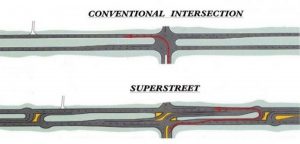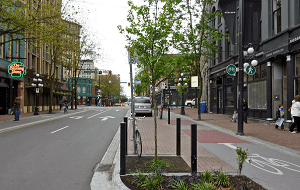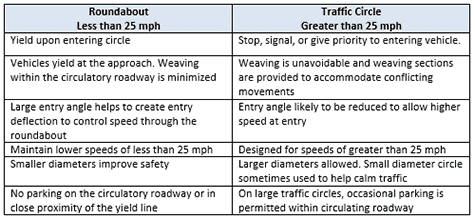Safety and efficiency are always a priority when planning communities, towns, and cities. From the street designs to sidewalks, bus stops, and crosswalks, engineers consider many factors before handing over their blueprints to the builders.
Thanks to innovative research and design, modern street designs have been improving the welfare and community aspect of the places we live, work, learn, and play.
Yet for property and business owners whose land is taken for the streets or for a right of way, it can become a financial burden.
Here, we offer a bit of information on four street designs you may have seen being constructed in North Carolina towns and communities. And we offer information on what you can do if your property lies in the NCDOT’s crosshairs when building these new street designs.
Superstreets

Superstreets are designed primarily to try to eliminate the dangers of left turns at intersections. Their construction has been proven to result in significantly faster travel times and a reduced percentage of drivers involved in accidents.
Superstreets help to prevent left-turn accidents by forcing traffic on a side road to first turn right and then access a U-turn lane to turn left. Traffic on the main road can turn left directly.
While having to first turn right then make a U-turn to turn left may seem time-consuming and inconvenient, it actually results in a significant time savings since drivers do not have to wait to make left-hand turns or for traffic from cross-streets to go across the intersection, according to a North Carolina State University study. This study on the superstreet is the largest study ever conducted regarding the impact superstreets have on travel time and safety. Not only did the study show a 20% reduction in travel time over conventional traffic designs, it found that superstreet intersections experience an average of 46% percent fewer reported automobile collisions and 63% percent fewer collisions that result in personal injury.
Superstreets have been shown to be so effective in reducing accidents and improving travel time that five of them were incorporated as a part of the U.S. 17 upgrades near Wilmington.
Unfortunately, for some business owners on the path of a street that is redesigned as a superstreet, the drawbacks can be significant. Some customers may no longer want to make that U-turn to go visit the business or store.
Continuous flow intersection (CFI)
A continuous flow intersection (CFI), sometimes referred to as a displaced left-turn intersection, is an innovative design to help improve safety and mobility by redirecting some or all left turns at a major signalized intersection. As you can see from the video below, vehicles turning left cross into dedicated left-turn bays turning onto the cross street. The primary advantage is that traffic turning left and through traffic happen simultaneously. This helps reduce delays at intersections and increase safety by reducing the number of conflict points at the intersection.
Complete streets

Complete streets aim to offer improved traffic control by providing ramps that are cut into curbs to allow wheelchairs and strollers to cross the street with ease, as well as wider sidewalks and pedestrian areas, bus turn-off lanes, bike lanes, buffer zones, and greenery. Utilities are buried underground to make room for pedestrians. Environmentally friendly lighting is key, as is signage that can be seen by all travelers.
Yet someone’s property often has to be taken to make room for these new complete streets. Our eminent domain attorneys have been working with landowners since 2012 to help them try to get paid for the highest and best use of the property being taken.
Roundabouts and traffic circles
Many people think roundabouts and traffic circles are the same, but that’s not the case – although they do serve similar purposes. Roundabouts and traffic circles are commonly mistaken as the same thing because of their identical circular shape, but they have very distinct differences.
Traffic circles are typically larger than roundabouts and are designed to settle the flow of traffic in an aesthetically pleasing design. They also have stop signs and are typically utilized in areas with speeds greater than 25 mph.
Roundabouts are smaller than traffic circles and offer a four-way intersection or junction in which traffic flows almost continuously in one direction around a central island. There are no stop signs and each car yields. Roundabouts are designed for traffic traveling less than 25 mph.
Here are some of the primary distinctions of traffic circles and roundabouts.

Property taken for street redesign
Land takings and easements for these street designs (or any road construction project) can have a devastating impact on property and business owners. When the government exercises its right of eminent domain to take property needed to build a street, the property owners don’t have to simply accept whatever the government initially offers.
The government is required to pay fair compensation for what it takes and for the damage to the remaining property. Further, while a project may benefit the community or property owners as a whole, every property is unique, and some may experience more significant damages than others.
Our team has 100+ years of combined experience working on eminent cases. We have represented property owners who live along streets that are being redesigned and near intersections that are being changed, and we know how these changes often affect their homes or businesses. And we have seen the government undervalue properties and offer property owners less than what they potentially deserved.
We have the resources, experience, and relationships to help protect your rights as a property owner and fight for the highest potential compensation. In fact, since we have been in business, our firm has increased the average offer for our clients by 197%.1
Get a free case evaluation From the NC Eminent Domain Law Firm
If your property is on the NCDOT’s radar for any reason, we strongly urge you to talk with one of our experienced eminent domain attorneys. Our attorneys (several of whom used to work on behalf of the NCDOT) will evaluate your case for FREE. Complete the form on this page to contact us, or call 1-877-393-4990.

